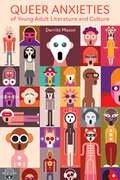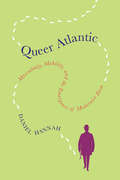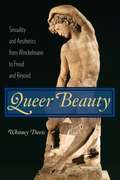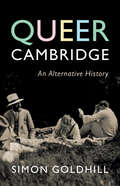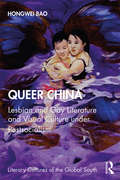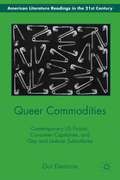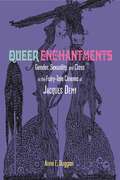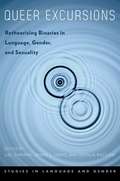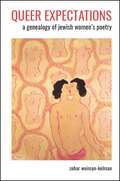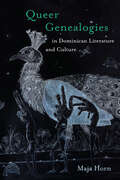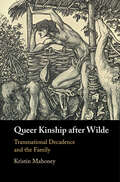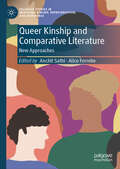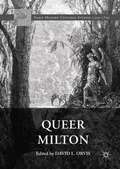- Table View
- List View
Queer Anxieties of Young Adult Literature and Culture (Children's Literature Association Series)
by Derritt MasonYoung adult literature featuring LGBTQ+ characters is booming. In the 1980s and 1990s, only a handful of such titles were published every year. Recently, these numbers have soared to over one hundred annual releases. Queer characters are also appearing more frequently in film, on television, and in video games. This explosion of queer representation, however, has prompted new forms of longstanding cultural anxieties about adolescent sexuality. What makes for a good “coming out” story? Will increased queer representation in young people’s media teach adolescents the right lessons and help queer teens live better, happier lives? What if these stories harm young people instead of helping them? In Queer Anxieties of Young Adult Literature and Culture, Derritt Mason considers these questions through a range of popular media, including an assortment of young adult books; Caper in the Castro, the first-ever queer video game; online fan communities; and popular television series Glee and Big Mouth. Mason argues themes that generate the most anxiety about adolescent culture—queer visibility, risk taking, HIV/AIDS, dystopia and horror, and the promise that “It Gets Better” and the threat that it might not—challenge us to rethink how we read and engage with young people’s media. Instead of imagining queer young adult literature as a subgenre defined by its visibly queer characters, Mason proposes that we see “queer YA” as a body of transmedia texts with blurry boundaries, one that coheres around affect—specifically, anxiety—instead of content.
Queer Atlantic: Masculinity, Mobility, and the Emergence of Modernist Form
by Daniel HannahThe instability of modernist form has everything to do with the social, political, and economic shakeups of the nineteenth century that left masculinity a site of contestation, racial anxiety, homophobic paranoia, performative display, and queer desire. Refusing to take white masculinity for granted, Daniel Hannah considers how the canonical novels of modernist fiction explore the ways that privilege is propped up and driven by factors of race, place, gender, and sexuality.Queer Atlantic examines the work of established writers – Herman Melville, Robert Louis Stevenson, Henry James, Joseph Conrad, and Ford Madox Ford – to reveal that anxieties surrounding white, masculine privilege and queer potential helped broaden the novel's formal possibilities. Demonstrating how masculine mobility, and often specifically transatlantic mobility, both enacts and queerly disorients male privilege, Hannah places these writers in the context of debates about naval impressment, piracy, emigration, colonization, and the "new imperialism." In the process he raises important questions about the current field of queer ethics, highlighting the strange companionship of queer openness to otherness and imperialist thought in modernist writing.Arguing for the surprising resilience of such fictional structures, Queer Atlantic provides a new understanding of modernism's emergence from a troubling of masculine privilege, mobility, and desire.
Queer Beauty: Sexuality and Aesthetics from Winckelmann to Freud and Beyond (Columbia Themes in Philosophy, Social Criticism, and the Arts)
by Whitney DavisThe pioneering work of Johann Winckelmann (1717-1768) identified a homoerotic appreciation of male beauty in classical Greek sculpture, a fascination that had endured in Western art since the Greeks. Yet after Winckelmann, the value (even the possibility) of art's queer beauty was often denied. Several theorists, notably the philosopher Immanuel Kant, broke sexual attraction and aesthetic appreciation into separate or dueling domains. In turn, sexual desire and aesthetic pleasure had to be profoundly rethought by later writers. Whitney Davis follows how such innovative thinkers as John Addington Symonds, Michel Foucault, and Richard Wollheim rejoined these two domains, reclaiming earlier insights about the mutual implication of sexuality and aesthetics. Addressing texts by Arthur Schopenhauer, Charles Darwin, Oscar Wilde, Vernon Lee, and Sigmund Freud, among many others, Davis criticizes modern approaches, such as Kantian idealism, Darwinism, psychoanalysis, and analytic aesthetics, for either reducing aesthetics to a question of sexuality or for removing sexuality from the aesthetic field altogether. Despite these schematic reductions, sexuality always returns to aesthetics, and aesthetic considerations always recur in sexuality. Davis particularly emphasizes the way in which philosophies of art since the late eighteenth century have responded to nonstandard sexuality, especially homoeroticism, and how theories of nonstandard sexuality have drawn on aesthetics in significant ways. Many imaginative and penetrating critics have wrestled productively, though often inconclusively and "against themselves," with the aesthetic making of sexual life and new forms of art made from reconstituted sexualities. Through a critique that confronts history, philosophy, science, psychology, and dominant theories of art and sexuality, Davis challenges privileged types of sexual and aesthetic creation imagined in modern culture-and assumed today.
Queer Callings: Untimely Notes on Names and Desires
by Mark D. JordanCHOICE: OUTSTANDING ACADEMIC TITLEFINALIST, THE RANDY SHILTS AWARD FOR GAY NONFICTION, THE PUBLISHING TRIANGLE AWARDSA passionate exhortation to expand the ways we talk about human sex, sexuality, and gender.Twenty-five years ago, Mark D. Jordan published his landmark book on the invention and early history of the category “sodomy,” one that helped to decriminalize certain sexual acts in the United States and to remove the word sodomy from the updated version of a standard English translation of the Christian Bible. In Queer Callings, Jordan extends the same kind of illuminating critical analysis to present uses of “identity” with regard to sexual difference. While the stakes might not seem as high, he acknowledges, his newest history of sexuality is just as vital to a better present and future.Shaking up current conversations that focus on “identity language,” this essential new book seeks to restore queer languages of desire by inviting readers to consider how understandings of “sexual identity” have shifted—and continue to shift—over time. Queer Callings re-reads texts in various genres—literary and political, religious and autobiographical—that have been preoccupied with naming sex/gender diversity beyond a scheme of LGBTQ+ identities. Engaging a wide range of literary and critical works concerned with sex/gender self-understanding in relation to “spirituality,” Jordan takes up the writings of Oscar Wilde, Marcel Proust, Djuna Barnes, Samuel R. Delany, Audre Lorde, Geoff Mains, Eve Kosofsky Sedgwick, Gloria Anzaldúa, Maggie Nelson, and others.Before it’s possible to perceive sexual identities differently, Jordan argues, current habits for classifying them have to be disrupted. In this way, Queer Callings asks us to reach beyond identity language and invites us to re-perform a selection of alternate languages—some from before the invention of phrases like “sexual identity,” others more recent. Tracing a partial genealogy for “sexual identity” and allied phrases, Jordan reveals that the terms are newer than we might imagine. Many queer folk now counted as literary or political ancestors didn’t claim a sexual or gender identity: They didn’t know they were supposed to have one. Finally, Queer Callings joins the writers it has evoked to resist any remaining confidence that it’s possible to give neatly contained accounts of human desire. Reaching into the past to open our eyes to extraordinary opportunities in our present and future, Queer Callings is a generatively destabilizing and essential read.
Queer Cambridge: An Alternative History
by Simon GoldhillQueer Cambridge recounts the untold story of a gay community living, for many decades, at the very heart of the British Establishment. Making effective use of chiefly forgotten archival sources – including personal diaries and letters – the author reveals a network that was in equal parts tolerant and acerbic, and within which the queer Fellows of Cambridge University explored bold new forms of camaraderie and relationship. Goldhill examines too the huge influence that these individuals had on British culture, in its arts, politics, music, theatre and self-understanding. During difficult decades when homosexuality was unlawful, gay academics – who included celebrated literary and scientific figures like E. M. Forster, M. R. James, Rupert Brooke and Alan Turing – lived, loved, and grew old together, bringing new generations into their midst. Their remarkable stories add up not just to an alternative history of male homosexuality in Britain, but to an alternative history of Cambridge itself.
Queer China: Lesbian and Gay Literature and Visual Culture under Postsocialism (Literary Cultures of the Global South)
by Hongwei BaoThis book analyses queer cultural production in contemporary China to map the broad social transformations in gender, sexuality and desire. It examines queer literature and visual cultures in China’s post-Mao and postsocialist era to show how these diverse cultural forms and practices not only function as context-specific and culturally sensitive forms of social activism but also produce distinct types of gender and sexual subjectivities unique to China’s postsocialist conditions. From poetry to papercutting art, from ‘comrade/gay literature’ to girls’ love fan fiction, from lesbian films to activist documentaries, and from a drag show in Shanghai to a public performance of a same-sex wedding in Beijing, the book reveals a queer China in all its ideological complexity and creative energy. Empirically rich and methodologically eclectic, Queer China skilfully weaves together historical and archival research, textual and discourse analysis, along with interviews and ethnography. Breaking new ground and bringing a non-Western perspective to the fore, this transdisciplinary work contributes to multiple academic fields including literary and cultural studies, media and communication studies, film and screen studies, contemporary art, theatre and performance studies, gender and sexuality studies, China/Asia and Global South studies, cultural history and cultural geography, political theory and the study of social movements.
Queer Chivalry: Medievalism and the Myth of White Masculinity in Southern Literature (Southern Literary Studies)
by Tison PughFor the U.S. South, the myth of chivalric masculinity dominates the cultural and historical landscape. Visions of white southern men as archetypes of honor and gentility run throughout regional narratives with little regard for the actions and, at times, the atrocities committed by such men. In Queer Chivalry, Tison Pugh exposes the inherent contradictions in these depictions of cavalier manhood, investigating the foundations of southern gallantry as a reincarnated and reauthorized version of medieval masculinity. Pugh argues that the idea of masculinity -- particularly as seen in works by prominent southern authors from Mark Twain to Ellen Gilchrist -- constitutes a cultural myth that queerly demarcates accepted norms of manliness, often by displaying the impossibility of its achievement. Beginning with Twain's famous critique of "the Sir Walter disease" that pilloried the South, Pugh focuses on authors who questioned the code of chivalry by creating protagonists whose quests for personal knighthood prove quixotic. Through detailed readings of major works -- including Twain's A Connecticut Yankee in King Arthur's Court, Flannery O'Connor's short fiction, John Kennedy Toole's A Confederacy of Dunces, Robert Penn Warren's A Place to Come To, Walker Percy's novels, and Gilchrist's The Annunciation -- Pugh demonstrates that the hypermasculinity of white-knight ideals only draws attention to the ambiguous gender of the literary southern male.Employing insights from gender and psychoanalytic theory, Queer Chivalry contributes to recent critical discussions of the cloaked anxieties about gender and sexuality in southern literature. Ultimately, Pugh uncovers queer limits in the cavalier mythos, showing how facts and fictions contributed to the ideological formulation of the South.
Queer Commodities
by Guy DavidsonQueer Commoditiesis the first book-length analysis of same-sexuality and consumer capitalism in contemporary US fiction. Moving beyond the critical tendencies to identify gay and lesbian subcultures as either hopelessly immersed in consumer capitalism or heroically resistant to it, Guy Davidson argues that while these subcultures are necessarily commodified, they also provide means of subversively negotiating aspects of life under capitalism.
Queer Communication Pedagogy (Routledge Research in Communication Studies)
by Ahmet Atay Sandra L. Pensoneau-ConwayThis book addresses queer issues and current events from a communication perspective to articulate a queer communication pedagogy. Through putting communication pedagogy and queer studies into dialogue, the book investigates how queer theory and critical communication pedagogy intersect in pedagogical spaces. The chapters identify institutional and educational barriers, oppressions, and issues pertaining to queer lives in the context of higher education. Using a variety of critical methodological approaches (including dialogic methods, autoethnography, performative writing, and visual methods), each chapter theorizes a queer communication pedagogy, and offers a path toward and innovative ideas about materializing queer communication pedagogy as a disciplinary endeavor. This book will be of interest to scholars, graduate students, and upper-level undergraduate students in Communication Studies, Critical Communication Pedagogy, Intercultural Communication, Higher Education, Public Pedagogy, and Queer Studies, and Critical/Cultural Studies.
Queer Enchantments: Gender, Sexuality, and Class in the Fairy-Tale Cinema of Jacques Demy
by Anne E. DugganTo the uninitiated, the films of French New Wave director Jacques Demy can seem strange and even laughable, with their gaudy color schemes and sung dialogue. Yet since the late 1990s, a generation of queer filmmakers in France have found new inspiration in Demy's cinema. In this volume, author Anne E. Duggan examines Jacques Demy's queer sensibility in connection with another understudied characteristic of his oeuvre: his recurrent use of the fairy tale. In Queer Enchantments: Gender, Sexuality, and Class in the Fairy-Tale Cinema of Jacques Demy, Duggan demonstrates that Demy uses fairy-tale devices to explore and expand the identity categories of his characters, while he broadens the possibilities of the genre of the fairy tale through his cinematic revisions. In each chapter, Duggan examines how Demy strategically unfolds, challenges, and teases out the subversive qualities of fairy-tale paradigms. In chapter 1, Duggan reads Demy's Lola and The Umbrellas of Cherbourg through the lens of "Cinderella" and "Sleeping Beauty," while in chapter 2, she explores Demy's revision of Charles Perrault's "Donkey Skin" from the particular angle of gay aesthetics. In chapter 3, Duggan situates Demy's rendition of The Pied Piper in relation to a specifically Franco-American tradition of the legend, which thus far has not received critical attention. Finally, in Chapter 4, she examines the ways in which Demy's Lady Oscar represents the undoing of the figure of the maiden warrior. An epilogue reads Demy's fairy-tale cinema as exemplary of the postmodern tale. Duggan shows that Demy's cinema heightens the inherent tensions and troubles that were already present in fairy-tale texts and uses them to illustrate both the constraints and utopian possibilities of the fairy tale. Both film and fairy-tale studies scholars will enjoy Duggan's fresh look at the distinctive cinema of Jacques Demy.
Queer Excursions: Retheorizing binaries in Language, Gender, and Sexuality (Studies in Language and Gender, and Sexuality series)
by Lal Zimman Joshua Raclaw Jenny L. DavisThe chapters in Queer Excursions offer a series of distinct perspectives on these binaries, as well as on a number of other, less immediately apparent dichotomies that nevertheless permeate the gendered and sexual lives of speakers. Several chapters focus on the limiting or misleading qualities of bi-naristic analyses, while others suggest that binaries are a crucial component of social meaning within particular communities of study.
Queer Expectations: A Genealogy of Jewish Women's Poetry (SUNY series in Contemporary Jewish Literature and Culture)
by Zohar Weiman-KelmanJewish women have had a fraught relationship with history, struggling for inclusion while resisting their limited role as (re)producers of the future. In Queer Expectations, Zohar Weiman-Kelman shows how Jewish women writers turned to poetry to write new histories, developing "queer expectancy" as a conceptual tool for understanding how literary texts can both invoke and resist what came before. Bringing together Jewish women's poetry from the late nineteenth century, the interwar period, and the 1970s and 1980s, Weiman-Kelman takes readers on a boundary-crossing journey through works in English, Yiddish, and Hebrew, setting up encounters between writers of different generations, locations, and languages. Queer Expectations highlights genealogical lines of continuity drawn by authors as diverse as Emma Lazarus, Kadya Molodowsky, Leah Goldberg, Anna Margolin, Irena Klepfisz, and Adrienne Rich. These poets push back against heteronormative imperatives of biological reproduction and inheritance, opting instead for connections that twist traditional models of gender and history. Looking backward in queer ways enables new histories to emerge, intervenes in a troubled present, and gives hope for unexpected futures.
Queer Experimental Literature: The Affective Politics of Bad Reading (Palgrave Studies in Affect Theory and Literary Criticism)
by Tyler BradwayThis volume argues that postwar writers queer the affective relations of reading through experiments with literary form. Tyler Bradway conceptualizes “bad reading” as an affective politics that stimulates queer relations of erotic and political belonging in the event of reading. These incipiently social relations press back against legal, economic, and discursive forces that reduce queerness into a mode of individuality. Each chapter traces the affective politics of bad reading against moments when queer relationality is prohibited, obstructed, or destroyed—from the pre-Stonewall literary obscenity debates, through the AIDS crisis, to the emergence of neoliberal homonormativity and the gentrification of the queer avant-garde. Bradway contests the common narrative that experimental writing is too formalist to engender a mode of social imagination. Instead, he illuminates how queer experimental literature uses form to redraw the affective and social relations that structure the heteronormative public sphere. Through close readings informed by affect theory, Queer Experimental Literature offers new perspectives on writers such as William S. Burroughs, Samuel R. Delany, Kathy Acker, Jeanette Winterson, Eve Kosofsky Sedgwick, Alison Bechdel, and Chuck Palahniuk. Queer Experimental Literature ultimately reveals that the recent turn to affective reading in literary studies is underwritten by a para-academic history of bad reading that offers new idioms for understanding the affective agencies of queer aesthetics.
Queer Faith: Reading Promiscuity and Race in the Secular Love Tradition (Sexual Cultures #52)
by Melissa E. SanchezHonorable Mention, 2020 Aldo and Jeanne Scaglione Prize, given by the Modern Language AssociationUncovers the queer logics of premodern religious and secular textsPutting premodern theology and poetry in dialogue with contemporary theory and politics, Queer Faith reassess the commonplace view that a modern veneration of sexual monogamy and fidelity finds its roots in Protestant thought. What if this narrative of “history and tradition” suppresses the queerness of its own foundational texts? Queer Faith examines key works of the prehistory of monogamy—from Paul to Luther, Petrarch to Shakespeare—to show that writing assumed to promote fidelity in fact articulates the affordances of promiscuity, both in its sexual sense and in its larger designation of all that is impure and disorderly. At the same time, Melissa E. Sanchez resists casting promiscuity as the ethical, queer alternative to monogamy, tracing instead how ideals of sexual liberation are themselves attached to nascent racial and economic hierarchies. Because discourses of fidelity and freedom are also discourses on racial and sexual positionality, excavating the complex historical entanglement of faith, race, and eroticism is urgent to contemporary queer debates about normativity, agency, and relationality.Deliberately unfaithful to disciplinary norms and national boundaries, this book assembles new conceptual frameworks at the juncture of secular and religious thought, political and aesthetic form. It thereby enlarges the contexts, objects, and authorized genealogies of queer scholarship. Retracing a history that did not have to be, Sanchez recovers writing that inscribes radical queer insights at the premodern foundations of conservative and heteronormative culture.
Queer Festivals: Challenging Collective Identities in a Transnational Europe (Protest and Social Movements)
by Konstantinos EleftheriadisTo what extent is queer anti-identitarian? And how is it experienced by activists at the European level? At queer festivals, activists, artists and participants come together to build new forms of sociability and practice their ideals through anti-binary and inclusive idioms of gender and sexuality. These ideals are moreover channelled through a series of organisational and cultural practices that aim at the emergence of queer as a collective identity. Through the study of festivals in Amsterdam, Berlin, Rome, Copenhagen, and Oslo, Queer Festivals: Challenging Collective Identities in a Transnational Europe thoughtfully analyses the role of activist practices in the building of collective identities for social movement studies as well as the role of festivals as significant repertoires of collective action and sites of identitarian explorations in contemporary Europe.
Queer Friendship: Male Intimacy in the English Literary Tradition
by George E. HaggertyFriendship in the classical world was celebrated as among the highest human achievements: nothing was more likely to lead to the divine than looking for it in the eyes of a friend. In exploring the complexities of male-male relations beyond the simple labels of sexuality, Queer Friendship shows how love between men has a rich and varied history in English literature. The friend could offer a reflection of one's own worth and a celebration of a kind of mutuality that was not connected to family or home. These same-sex friendships are memorable because they give shape to the novels of which they are a part, and question the assumption that the love between friends is different from the love between lovers. Queer Friendship explores English literary friendship in three ways: the elegiac, the erotic, and the platonic, by considering a myriad of works, including Sterne's Tristram Shandy, Tennyson's 'In Memoriam A. H. H.', and Dickens' Great Expectations.
Queer Genealogies in Dominican Literature and Culture
by Maja HornTracing cultural representations of queerness in the Dominican Republic from the 1950s to the present In this book, Maja Horn examines the evolution of queer Dominican literary and cultural production from the 1950s to the present, challenging simplistic developmental narratives of LGBTIQ+ progress. Through an analysis of literature, theater, and activism, Horn traces how same-sex desire and gender nonconformity have been negotiated both tacitly and overtly across the years.Beginning with early forerunners, Horn looks at literary representations in works by Hilma Contreras and Pedro René Contín Aybar during the 1930–1961 dictatorship of Rafael Trujillo. Horn goes on to explore the emergence of queer nightlife spaces during the Balaguer years through novels by Rita Indiana Hernández and Rey Emmanuel Andújar. Horn discusses how the work of playwright Waddys Jáquez challenges reductive mainstream representations of trans subjects and HIV/AIDS in the new democratic era. The book concludes with a discussion of groundbreaking recent texts that have expanded portrayals beyond Santo Domingo and introduced new perspectives.Throughout Queer Genealogies in Dominican Literature and Culture, Horn shows how class, race, and gender have shaped access to public space and strategies for negotiating sexuality. Horn also reveals the coexistence of different ways of expressing queer identities. Recognizing the influence of coloniality and narratives of identity in the global North, Horn celebrates the shifting geographies and multiplicities of a uniquely creole Dominican queerness.
Queer Iberia: Sexualities, Cultures, and Crossings from the Middle Ages to the Renaissance
by Josiah Blackmore Gregory S. HutchesonMartyred saints, Moors, Jews, viragoes, hermaphrodites, sodomites, kings, queens, and cross-dressers comprise the fascinating mosaic of historical and imaginative figures unearthed in Queer Iberia. The essays in this volume describe and analyze the sexual diversity that proliferated during the period between the tenth and the sixteenth centuries when political hegemony in the region passed from Muslim to Christian hands. To show how sexual otherness is most evident at points of cultural conflict, the contributors use a variety of methodologies and perspectives and consider source materials that originated in Castilian, Latin, Arabic, Catalan, and Galician-Portuguese. Covering topics from the martydom of Pelagius to the exploits of the transgendered Catalina de Erauso, this volume is the first to provide a comprehensive historical examination of the relations among race, gender, sexuality, nation-building, colonialism, and imperial expansion in medieval and early modern Iberia. Some essays consider archival evidence of sexual otherness or evaluate the use of "deviance" as a marker for cultural and racial difference, while others explore both male and female homoeroticism as literary-aesthetic discourse or attempt to open up canonical texts to alternative readings. Positing a queerness intrinsic to Iberia's historical process and cultural identity, Queer Iberia will challenge the field of Iberian studies while appealing to scholars of medieval, cultural, Hispanic, gender, and gay and lesbian studies. Contributors. Josiah Blackmore, Linde M. Brocato, Catherine Brown, Israel Burshatin, Daniel Eisenberg, E. Michael Gerli, Roberto J. Gonzlez-Casanovas, Gregory S. Hutcheson, Mark D. Jordan, Sara Lipton, Benjamin Liu, Mary Elizabeth Perry, Michael Solomon, Louise O. Vasvri, Barbara Weissberger
Queer Impressions: Henry James' Art of Fiction (Studies in Major Literary Authors)
by Elaine PigeonBeginning with The Portrait of a Lady, this book shows how, in developing his unique form of realism, James highlights the tragic consequences of his American heroine's Romantic imagination, in particular, her Emersonian idealism. In order to expose Emerson's blind spot, a lacuna at the very centre of his New England Transcendentalism, James draws on the Gothic effects of Nathaniel Hawthorne and Edgar Allan Poe, thereby producing an intensification of Isabel Archer's psychological state and precipitating her awakening to a fuller, heightened consciousness. Thus Romanticism takes an aesthetic turn, becoming distinctly Paterian and unleashing queer possibilities that are further developed in James's subsequent fiction. This book follows the Paterian thread, leading to The Author of Beltraffio and Théophile Gauthier, and thereby establishing an important connection with French culture. Drawing on James's famous analogy between the art of fiction and the art of the painter, the book explores a possible link to the Impressionist painters associated with the literary circle Émile Zola dominated. It then turns to A New England Winter, a tale about an American Impressionist painter, and finds traces leading back to James's initiation prèmiere. The book closes with an exploration of the possible sources of Kate Croy's unspeakable father in The Wings of the Dove and proposes a possible intertext, one that provides direct insight into the Victorian closet.
Queer Kinship after Wilde: Transnational Decadence and the Family
by Kristin MahoneyQueer Kinship after Wilde investigates the afterlife of the Decadent Movement's ideas about kinship, desire, and the family during the modernist period within a global context. Drawing on archival materials, including diaries, correspondence, unpublished manuscripts, and photograph albums, it tells the story of individuals with ties to late-Victorian Decadence and Oscar Wilde who turned to the fin-de-siècle past for inspiration as they attempted to operate outside the heteronormative boundaries restricting the practice of marriage and the family. These post-Victorian Decadents and Decadent modernists engaged in translation, travel, and transnational collaboration in pursuit of different models of connection that might facilitate their disentanglement from conventional sexual and gender ideals. Queer Kinship after Wilde attends to the successes and failures that resulted from these experiments, the new approaches to affiliation inflected by a cosmopolitan or global perspective that occurred within these networks as well as the practices marked by Decadence's troubling patterns of Orientalism and racial fetishism.
Queer Kinship and Comparative Literature: New Approaches (Palgrave Studies in Mediating Kinship, Representation, and Difference)
by Alice Ferrebe Anchit SathiThis edited collection provides a critical forum for scholars to examine the evolution of queer kinship—encompassing the wide range of relationships, both biological and nonbiological, that queer individuals choose (or are compelled) to establish—through its representation in literature over time and across cultural contexts. In particular, the ten essays in this collection utilize close readings, philosophy, and theory to address the following question: How can we conceptualize the nature of queer kinship based on its textual representations? To this end, the essays engage with a diverse array of texts, from Buddhist writing to contemporary song lyrics, French literature from the 17th and 18th centuries to contemporary drama and novels from Sweden, Israel, and the Anglosphere. This broad temporal and geographic scope yields new critical insights into the varied ontologies of queer kinship and highlights the inherent paradoxes and fundamental messiness in queer kinship formations across different times, spaces, and contexts. In doing so, the collection makes a significant and timely contribution to the fields of kinship studies, queer studies, and comparative literature.
Queer Kinship in Sarah Schulman’s AIDS Novels (Routledge Studies in Twentieth-Century Literature)
by Jarosław MilewskiQueer Kinship in Sarah Schulman’s AIDS Novels is the first book to extensively discuss the works of Sarah Schulman, a journalist, activist and globally recognized novelist. This research monograph juxtaposes the works about the AIDS epidemic which were well-received by the mainstream America with Schulman’s own output as a “bard of AIDS burnout,” in the words of Edmund White. In contrast with the prevailing representations of the epidemic, her works emphasize the importance of queer kinship, chosen families, and AIDS activist groups that fall outside of the heteronorm. Bearing witness to these voluntary collectivities means also surviving the traumatizing experience of ongoing, repeated death and refusing the idea of an easy solution to the crisis. The monograph tracks the tension between the dominant narratives about the epidemic and those articulated from the excluded positions, arguing that Schulman reformulates queer kinship as the locus of social change.
Queer Lasting: Ecologies of Care for a Dying World (Sexual Cultures)
by Sarah EnsorWhat queer modes of resilience and care can teach us about enduring environmental collapseWhat does it mean to live at the end of life, the end of a family line, the end of a species, or the end of the future itself? When faced with unfurling catastrophes, environmentalists often limit the conversation by focusing on the future. Activists work for the welfare of future generations, while scientists labor over projections of future outcomes. In Queer Lasting, Sarah Ensor asks what this emphasis on the future makes unthinkable. She looks to queer scenes of futurelessness to consider what ecocriticism can learn from queer theory, which imagines and inhabits the immanent ethical possibilities of a terminal present. While living “at the last” is often a terrifying prospect, queer culture reminds us that “to last” is itself also one way to go on. Defining queerness as a mode of collective life in which these paradigms of lasting—ending and persisting—are constitutively intertwined, Ensor turns to two periods of queer extinction for models of care, continuance, and collective action predicated on futurelessness: the 1890s, in which existing forms of erotic affiliation were extinguished through the binary of homo/heterosexuality, and the 1980s, in which the spread of the AIDS epidemic threatened the total loss of gay lives and of specific erotic ways of life. Through readings that trace unexpected formal resonances across the works of Sarah Orne Jewett, Willa Cather, Melvin Dixon, Essex Hemphill, Allen Barnett, and Samuel Delany, Queer Lasting maintains that queer writing, in its intimacy with death and loss, offers a rich archive for imagining new ways of thinking through environmental collapse. Whether confronting the epidemic contours of the AIDS crisis, theorizing the temporary encounters of cruising, or reckoning with the lives of non-reproductive subjects, this book about futurelessness is also a book about persistence. It demonstrates how, far from giving up in the face of the terminal paradigms that environmentalism fears, queer culture has instead predicated its living—and its lasting—upon them.
Queer Milton (Early Modern Cultural Studies 1500–1700)
by David L. OrvisQueer Milton is the first book-length study dedicated to anti-heteronormative approaches to the poetry and prose of John Milton. Organized into sections on “Eroticism and Form” and “Temporality and Affect,” essays in this volume read Milton’s works through radical queer interpretive frameworks that have elsewhere animated and enriched Renaissance Studies. Leveraging insights from recent queer work and related fields, contributions demonstrate diverse possible futures for Queer Milton Studies. At the same time, Queer Milton bears witness to the capacity for queer to arbitrate debates that have shaped, and indeed continue to shape, developments in the field of Milton Studies.
Queer Narratives of the Caribbean Diaspora
by Zoran PecicThis book examines the concept of queer theory and combines it with the field of diaspora studies. By looking at the queer diasporic narratives in and from the Caribbean, it conducts an inquiry into the workings and underpinnings of both fields.
